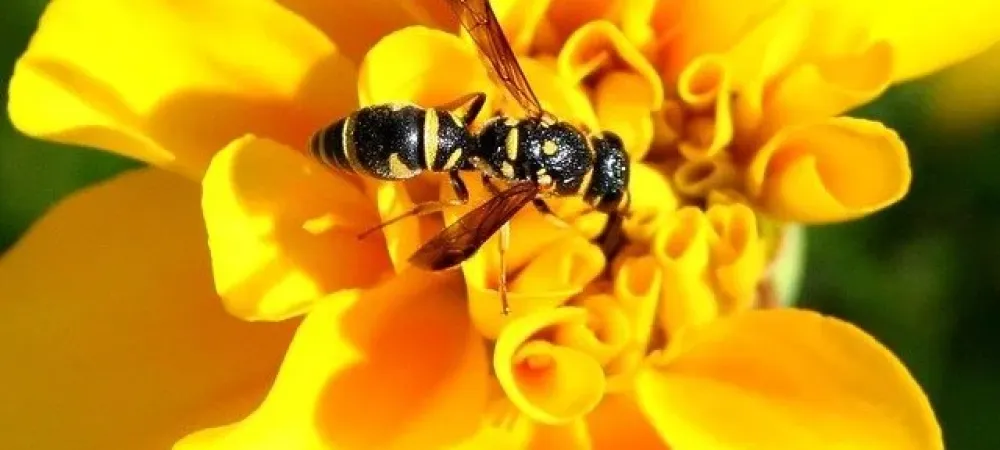The Dangers Of A Yellow Jacket Ground Nest

When your yard is scarier than a zombie apocalypse, you probably have yellow jackets. These bad-tempered insects are fiercely protective of their nests, and will grow agitated at any sign of danger. They fly in circular patterns, and draw into skin like a bead of metal to a magnet. Once there, the stinger in their bobbing tail can poke several times, if the yellow jacket is not swept off. For most people, these stings are like a hot poker on the skin. For others, the venom is toxic, and requires hospitalization. Of all the stinging insects you will run into this fall, yellow jackets are the most aggressive. You might even be wondering what purpose do yellow jackets serve?
Before we get into the dangers of yellow jacket ground nests, let's discuss the types of stinging insects you'll most likely encounter, and how to distinguish them from yellow jackets.
Bees
Bumblebees, honey bees, and africanized honey bees, are the bees you will most commonly see around your yard. All bees are somewhat yellow and black, and covered in fur--which they use to collect pollen.
Bumblebees are the largest, and the most docile. These large happy bees are great for gardens.
Honey bees are another docile creature, happy to pollinate your flowers, and create honey in their hive. These bees are often mistaken for yellow jackets. Look closely for the fur, to differentiate between the two.
Of all the bees you will encounter, africanized honey bees are the most aggressive ground bees. They will give chase if they consider you a threat. Fortunately, like all bees, they can only sting you once, and then they aren't long for this world. But, a swarm can sting you several times. So, watch out.
Wasps
Wasps come in many colors, and resemble bees without the fur. Their shiny plastic appearance gives them a deadly look, and for good reason. Wasps can sting multiple times without losing their stinger. But in general, most wasps aren't interested in you, unless you threaten them. Yellow jackets are the exception to the rule. Though they are wasps, they are easily provoked.
Hornets
The only real difference between wasps and hornets is that hornets are fatter, and more aggressive. The one exception to this rule are the yellow jackets. There is nothing more aggressive than a yellow jacket.
Yellow jackets make their nests in trees, and in holes dug out by squirrels, moles, chipmunks, groundhogs, and other digging mammals. These ground nests are the worst, because the ground offers protection against easy removal, and because they are much harder to see. The only indication that yellow jackets are present, is the entering and exiting of wasps from their hole, and these holes can be quite small.
Being underground creates another problem, because vibration can cause yellow jackets to get defensive, and they will fly out in a swarm to protect their nest. The simple act of mowing the lawn, or watering flowers, can instigate fierce and painful response from a nest of yellow jackets.
Yellow Jackets
When it comes to dealing with pests, there are few insects more feared than the yellow jacket. These aggressive wasps are known for their painful stings, and their habit of nesting in the ground can make them difficult to deal with. If you have a yellow jacket ground nest on your property, it's important to take steps to remove it as soon as possible.
Yellow jacket stings can be deadly if you're allergic, and even if you're not allergic, a yellow jacket sting can be extremely painful. These stings also tend to swell up and itch, which can be very uncomfortable. In some cases, the swelling can be so severe that it interferes with breathing.
Yellow jackets are most active during the day, so this is when you're most likely to be stung. If you see a yellow jacket flying around, it's important to stay away from it. These insects are attracted to movement, so if you wave your arms or run away, you're more likely to be stung.
Do Yellow Jackets Live in the Ground?
Yes, yellow jackets do live in the ground. In fact, they are quite adept at excavating their own nests underground. These nests can be quite large and may house thousands of yellow jackets. If you have a yellow jacket nest on your property, it is important to have it removed by a professional. Otherwise, you may be at risk of being stung.
Why are yellow jacket ground nests dangerous?
There are various reasons why yellow jacket ground nests can be dangerous to you and your family. Yellow Jacket ground nests can be dangerous because:
1. They're difficult to spot. Yellow jacket ground nests can be small and well-hidden, making them hard to find until it's too late.
2. They're located in areas where people typically walk or play. This means that there's a greater likelihood of someone coming into contact with a yellow jacket, and getting stung.
3. They can contain hundreds or even thousands of yellow jackets. This means that if someone does disturb the nest, they could be swarmed by a large number of angry, stinging insects.
4. The venom from a yellow jacket sting can be potent, and in some cases, even deadly. This is especially true for those who are allergic to bee stings.
5. Yellow jackets are aggressive defenders of their nests. If they feel that their nest is threatened, they will not hesitate to attack. This can result in multiple stings, which can be very painful and potentially dangerous.
How To Avoid Stinging Insects
To avoid coming into contact with these yellow jackets and other stinging insects, follow these tips:
- Always wear shoes when working or spending time outdoors. The yellow jacket is known for building nests in the ground and accidentally stepping on a yellow jacket nest could leave you covered in painful stings.
- Avoid wearing floral scented perfumes or lotions while spending time outdoors. When you smell like a flower, a hungry stinging insect may land on you, looking for nectar.
- Keep the brightly colored clothes in the closet; bright colors attract yellow jackets to your body the same way brightly colored flowers attract these insects.
- Periodically check your property for nests and hives. Look under eaves, around soffits, under decking and even inside crawl spaces if you have access. By locating a nest before it gets too large, you can have it removed immediately, reducing the populations of stinging insects that may frequent your property.
- Don’t make sharp or erratic movements if you have a yellow jacket hovering around you. This can cause the insect to become aggressive, increasing the chance you will be stung.
If your home and yard are prone to yellow jacket nesting, don't risk being stung, get a professional to come and root out those nests. Filling a nest hole with water will only infuriate these wasps. And using a can of wasp spray has the potential to produce dangerous results. Underground nests can be quite large, and the wasps at the bottom will crawl through the poisoned carcasses of their fallen brethren, to get to you. These wasps are not fun to mess with. Be safe and, get professional assistance from Witt. We offer expert pest control in Pennsylvania.
